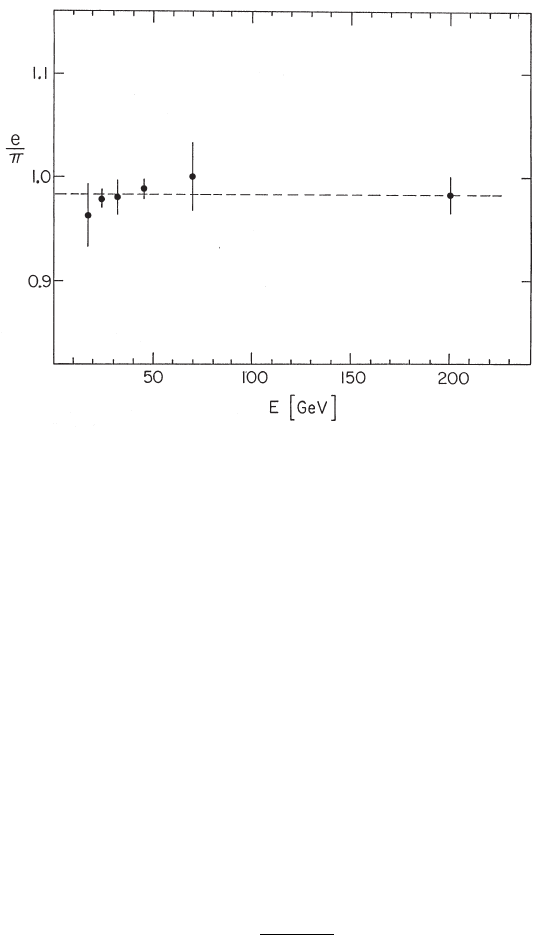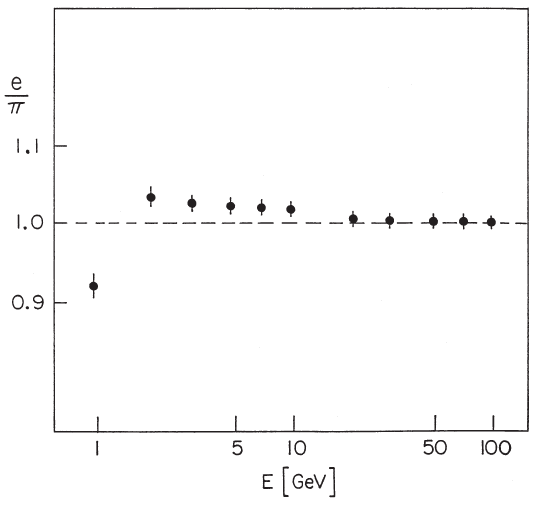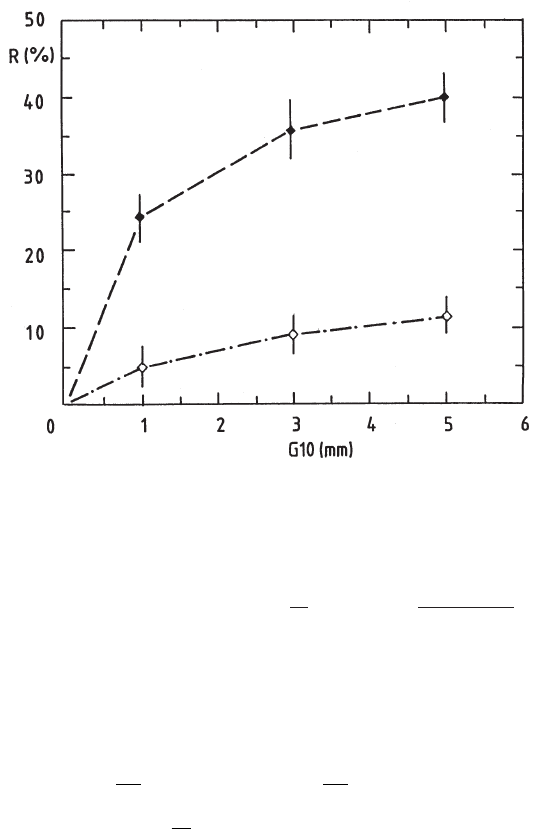Leroy C., Rancoita P.-G. Principles Of Radiation Interaction In Matter And Detection
Подождите немного. Документ загружается.


January 9, 2009 10:21 World Scientific Book - 9.75in x 6.5in ws-bo ok975x65˙n˙2nd˙Ed
680 Principles of Radiation Interaction in Matter and Detection
errors, for incoming hadron energies ≥ 10 GeV.
9.9.1 Compensation Condition by Detecting Neutron Energy
The role of neutron energy detection in compensating or almost compensating ca-
lorimetry and, in particular, the role of the nuclear fission in the building of the
signal of uranium calorimeters (see e.g., [Leroy, Sirois and Wigmans (1986)]) have
intensively investigated experimentally and, also, by using Monte-Carlo simulations
(e.g., see [Fabjan et al. (1977); Abramowicz et al. (1981); De Vincenzi et al. (1986);
Bernardi et al. (1987); HELIOS Collab. (1987); Drews et al. (1990); Ros (1991)],
and also [Wigmans (1987); Br¨uckmann et al. (1988)], Section 3.3.3.2 in [Wigmans
(2000)]).
In hadronic cascades, neutrons (n) are produced either by spallation
¶
or, mostly,
are evaporated from highly excited nuclear fragments (see [Fraser et al. (1965); Pat-
terson and Thomas (1981); Brau and Gabriel (1985); Leroy, Sirois and Wigmans
(1986); Wigmans (1987); Br¨uckmann et al. (1988)] and references therein). The
energy spectrum has a peak below 10 MeV, corresponding to evaporation neu-
trons. For heavy elements, the evaporation peak is slightly shifted to lower ener-
gies. For fissionable nuclei (
238
U), a large amount of fast neutrons are generated ow-
ing to subsequent fission processes. Those neutrons with energies larger than ab out
1 MeV are likely to dissipate their energy through inelastic (n,γ) reactions on heavy
nuclei. At lower energies (below 100 keV), neutrons are captured by nuclei. Neutrons
emerging with energies ab ove 10 MeV are mainly produced by spallation processes
and have an energy spectrum almost independent of the atomic number of the ab-
sorber element. The few very highly energetic neutrons, that are generated, travel
some distance inside the calorimeter before interacting. They behave similarly to
highly energetic charged hadrons. Furthermore, the longitudinal profile of neutron
generated in hadronic cascades was measured in iron and lead absorbers for in-
coming hadrons of 24 and 200 GeV ([Russ et al. (1991)] and references therein).
The proton-induced neutron yield, Y (E, A), was measured from light to heavy
nuclei with incoming protons above ≈ 0.5 GeV [Fraser et al. (1965)]. To a first
approximation, it is given by [Patterson and Thomas (1981)]:
Y (E, A) = 0.1 × (E − 0.12)(A + 20), for non-fissionable nuclei (9.63)
and
Y (E, A) = 50 × (E − 0.12), for fissionable nuclei (like
238
U), (9.64)
where E (in GeV) is the incoming hadron energy and A is the target mass.
From Eqs. (9.63, 9.64), we expect ≈ 45 n/GeV per incoming proton on depleted
uranium absorbers and ≈ 20 n/GeV on lead absorber. These values agree with the
¶
The relative probability of neutron-to-proton spallation increases as A increases, because the
Z/A ratio decreases.

January 9, 2009 10:21 World Scientific Book - 9.75in x 6.5in ws-bo ok975x65˙n˙2nd˙Ed
Principles of Particle Energy Determination 681
Fig. 9.22 The measured e/π ratio with the compensating uranium/scintillator calorimeter real-
ized by the HELIOS Collaboration (reprinted from Nucl. Instr. and Meth. in Phys. Res. A 262,
˚
Akesson, T. et al., Performance of the uranium/plastic scintillator calorimeter for the HELIOS
experiment at CERN, 243–263, Copyright (1987), with permission from Elsevier, e.g., for the list
of the authors see [HELIOS Collab. (1987)]; see also [Leroy and Rancoita (2000)]).
experimental data from [Fraser et al. (1965); Leroy, Sirois and Wigmans (1986)]
(see also [Russ et al. (1991)] and references therein). Therefore, when uranium
absorbers are employed, the neutron yield is more than doubled with respect to a
high-A nucleus, such as lead.
In hadron calorimeters employing hydrogenous material as active devices, like
scintillators or scintillating fibers, the compensation condition can be achieved by
increasing the relative contribution of the pure hadronic signal, namely by increasing
the h/mip ratio. Indeed, the neutrons, generated in the last stages of the hadronic
cascade development where processes at the nuclear level occur, transfer part of
their energy (E
n
) to the protons of the scintillator. The maximum recoil energy
(E
R,max
) transferred from an incoming non-relativistic neutron to a recoiling nucleus
of atomic weight A is:
E
R,max
=
4A
(1 + A)
2
E
n
. (9.65)
For neutron–hydrogen collisions, the full energy of the neutron can be transferred to
the recoiling proton (E
p,R,max
), namely E
p,R,max
= E
n
. This results in an increase of
the hadronic signal, whose amount can be varied by modifying either the sampling
fraction or the ratio of the thicknesses of the passive sampler and the active medium,
i.e., by increasing the number of protons available as targets for neutrons [Leroy,

January 9, 2009 10:21 World Scientific Book - 9.75in x 6.5in ws-bo ok975x65˙n˙2nd˙Ed
682 Principles of Radiation Interaction in Matter and Detection
Sirois and Wigmans (1986)].
The increase of the hadronic signal is limited by the saturation of the scintillator
response, which occurs in the presence of dense ionization loss, i.e., for fast pro-
tons. In scintillators, this phenomenon was studied for many years and is described
to a first approximation
k
by Birks’ law [Birks (1951)] expressed in Eq. (5.4), where
dL/dx is the light yield per unit path length, dE/dx is the specific energy-loss by
collisions for the charged particle, S is the normal scintillation efficiency, the para-
meter kB (see [Knoll (1999)]) describes the quenching which occurs for high-density
ionization. Extended calculations regarding the saturation effect of the scintillator
response in hadronic calorimetry can be found in the literature, e.g., see [Brau and
Gabriel (1985); Brau et al. (1985); Brau and Gabriel (1989)].
The calorimeter performance also depends on the relative time response for
the various components of the calorimeter signal. The energy loss by collisions of
both charged relativistic particles and spallation protons occurs at a very short
time after the arrival of the incoming primary hadron. The temporal dependence of
fission and neutron capture was studied for uranium samplers (see e.g. [Brau and
Gabriel (1989)]). It lasts a few hundreds ns. The majority of the hadronic responses
of uranium calorimeters occurs in the first (50–100) ns. As consequence, the h/mip
ratio will depend on the integration time of the signal. The typical integration time
is about 100 ns.
A comp ensating uranium/plastic scintillator calorimeter was built by the HE-
LIOS Collaboration [HELIOS Collab. (1987)]. In Fig. 9.22, the e/π ratio, measured
up to 200 GeV, is shown. Their calorimeter modules consisted of uranium and scin-
tillator layers 3.0 mm and 2.5 mm thick, respectively. This calorimeter had a ratio
R
p/a
of ≈ 1.2, for the thicknesses of the passive relative to active samplers.
The compensation condition or an almost compensating condition were also
achieved by the ZEUS Collaboration (see [Klanner et al. (1988); d’Agostini et al.
(1989); Tiecke (1989); Behrens (1990); Drews et al. (1990); Ros (1991)] and referen-
ces therein), with devices for which the R
p/a
ratios were between 1.07 and 1.26. In
Fig. 9.23, the e/π ratio, measured up to 100 GeV with the ZEUS prototype calorime-
ter, is shown [Behrens (1990); Ros (1991)]. This calorimeter consisted in uranium
and scintillator layers 3.3 mm and 2.6 mm thick, respectively. The ZEUS Collabora-
tion measurements show the calorimeter is compensating or almost compensating
above (2–3) GeV, i.e., the e/π value is close to 1 indep endently of the incoming
hadron energy. However, as discussed in Sect. 9.8.1 and in [Wigmans (1987)], below
≈ 2 GeV the calorimeter properties, like the e/π value, differ from the intrinsic ones
at higher energies (see Fig. 9.23).
For R
p/a
values largely differing from ≈ 1.2, the uranium/plastic scintillator
calorimeter is no longer a compensating calorimeter. The measured e/π ratio, at
10 GeV, was ≈ 1.12 for R
p/a
≈ 0.8 [
˚
Akesson et al. (1985)] and ≈ 0.81 for R
p/a
≈
2.0 [Catanesi et al. (1987)]. Furthermore ([Br¨uckmann and Kowalski (1986); Ros
k
Other more refined approximations are given in [Knoll (1999)] and in references therein.

January 9, 2009 10:21 World Scientific Book - 9.75in x 6.5in ws-bo ok975x65˙n˙2nd˙Ed
Principles of Particle Energy Determination 683
Fig. 9.23 The measured e/π ratio with the compensating uranium/scintillator calorimeter real-
ized by the ZEUS Collaboration (reprinted from Nucl. Phys. B (Proc. Supp.) 23 (Issue 1), Ros,
E., Influence of instrumental effects on the performance of the ZEUS calorimeter, 51–61, Copyright
(1991), with permission from Elsevier; see also [Leroy and Rancoita (2000)] and [Behrens (1990)]).
(1991)] and references therein), the experimental data show a decrease (as expected)
of ≈ 7% in the e/π ratio when the integration times are increased from ≈ 100 ns to
≈ 1 µs.
An almost compensating lead/plastic scintillator calorimeter was built by the
ZEUS Collaboration [Bernardi et al. (1987)]. Their calorimeter modules consisted of
lead and scintillator layers 10.0 mm and 2.5 mm thick, respectively. This calorime-
ter had a ratio R
p/a
of ≈ 4 between the thicknesses of the passive to active sam-
plers. The measured e/π ratio was ≈ 1.05, above 10 GeV.
A consequence of these results is that the use of uranium is not an absolute
requirement to achieve compensation, when hydrogeneus detectors are employed as
readout media. However, it is fair to say that uranium still possesses the advantage
of easy calibration with the noise of its natural radioactivity. Furthermore, an almost
non-variable R
p/a
ratio of about 1.2 for passive uranium samplers and of about 4
for passive lead samplers is needed to achieve compensation with hydrogeneus active
media.
Lead and scintillating fibres (or strips) were used in calorimetry, for instance by
the SPACAL Collaboration ([Acosta et al. (1991); DeSalvo (1995)] and references
therein) and the CHORUS ([Buontempo et al. (1995)] and references therein). They

January 9, 2009 10:21 World Scientific Book - 9.75in x 6.5in ws-bo ok975x65˙n˙2nd˙Ed
684 Principles of Radiation Interaction in Matter and Detection
have achieved an e/π ratio ≈ 1.1 (or larger) at 10 GeV.
Data from Fe/scintillator calorimeter with a longitudinal tile configuration [Ariz-
tizabal et al. (1994)] show that such a calorimeter was not compensating (see
also [Botner (1981)]. The e/π ratio was larger than ≈ 1.2 at an incoming parti-
cle energy of 20 GeV.
Other readout media using hydrogeneous liquids were investigated ([Pripstein
(1991)] and references therein) for low-A (e.g., see [Aubert et al. (1993)]) and high-
A passive sampler. A detailed study of their almost compensating properties (as
a result of Monte-Carlo simulation predictions) is presented in [Brau and Gabriel
(1989)].
Hadronic calorimeters employing liquid argon
∗∗
as the active medium were and
are presently used in high-energy physics experiments (e.g., see [Fabjan et al. (1977);
H1 Collab. (1988); D0 Collab. (1989); SSC Detector R&D at BNL (1990); D0 Col-
lab. (1993); Axen et al. (1993); H1 Collab. (1993a); Gingrich et al. (1994); Guida
(1995); ATLAS Collab. (1997)] and references therein). These calorimeters are
also non-compensating, when uranium absorbers constitute the passive samplers
(e.g., see [Kondo et al. (1984)]).
The underlying phenomena that are resp onsible for the significant difference
with respect to the plastic scintillator calorimeters, are mainly explained taking
into account the neutron cross sections and the saturation effects of the active
medium (e.g., see [Brau and Gabriel (1985); Wigmans (1987); Brau and Gabriel
(1989)]). The neutron cross section on hydrogen continues to rise below (1–2) MeV,
while in argon falls. In this way, the neutron cross section is larger on hydrogen
than on argon nucleus. In addition, the maximum recoil energy transferred to an
argon nucleus is [from Eq. (9.65)] ≈ 9.5% of the incoming neutron energy, while it
is the entire neutron energy for an interaction on hydrogen. Therefore, on average,
the recoil nucleus will emerge with a lower velocity for the same incoming neutron
energy.
Following the suggestion of Brau and Gabriel (1985), saturation effects in li-
quid argon can be expressed in the form of Birks’ law [Eq. (5.4)]. In scintillators,
the value of the parameter kB is ≈ (0.01–0.02) g cm
2
MeV
−1
, while in liquid ar-
gon it is 0.0045 g cm
2
MeV
−1
[Fabjan et al. (1977); Babaev et al. (1979); Brau and
Gabriel (1985)]. For electrons at all energies, it is assumed that kB = 0. Although
liquid argon is less saturating than plastic scintillator, the kinematic constraint on
the energy transferred in neutron–nucleus collision leads (as mentioned above) to
a greater suppression of the signal, because the highly ionizing recoil nuclei receive
only one-tenth the relative energy of the less highly ionizing recoil protons in scin-
tillator. The e/mip ratio is also slightly larger in the case of liquid argon, whose
Z-value is larger than the one of plastic scintillator (see Sect. 9.2.2).
In uranium/liquid argon calorimetry, the e/π ratio measured at 10 GeV is ≈ 1.09
([D0 Collab. (1993)], e.g., see also [D0 Collab. (1989); Guida (1995)]), or even larger
∗∗
Reviews on liquid-argon calorimetry are given in [Gordon (1991); Fabjan (1995b)].
January 9, 2009 10:21 World Scientific Book - 9.75in x 6.5in ws-bo ok975x65˙n˙2nd˙Ed
Principles of Particle Energy Determination 685
(e.g., see [SSC Detector R&D at BNL (1990)]), depending on sampler thicknesses
and integration times.
Iron cladding of high-Z passive absorbers was investigated for reducing the e/π
ratio (e.g., see [Gordon (1991); Mockett and Boulware (1991)]), but the compensa-
tion is hardly achievable. It was also suggested (e.g. see [D0 Collab. (1989); Cennini
et al. (1990); Fabjan (1995b)]) that, by the addition of dopants containing hydrogen
(like methane) to liquid argon, the e/π ratio might be reduced. The experimental
results [D0 Collab. (1989)] do not confirm that the compensation condition can be
achieved when methane is added to liquid argon.
In large liquid-argon calorimeters, different passive samplers have often been
used inside the same device (e.g., [H1 Collab. (1988, 1993a); Gingrich et al. (1994);
ATLAS Collab. (1997)]). The choice of the types and the sequence of absorbers is
related to constraints coming from the experimental apparatus and the physics of
the experiment. In particular, lead absorbers were employed in the first part of the
device. This part is able to longitudinally contain almost all the energy deposited by
electromagnetic showers and is called the electromagnetic section. In the second part,
called the hadronic section, iron or copper absorbers were used. These calorime-
ters are intrinsically non-compensating, e.g., the measured e/π ratio is ≈ 1.17 at
20 GeV for the Pb (passive samplers of the electromagnetic section) and Cu (passive
samplers of the hadronic section) calorimeter of the H1 Collaboration [H1 Collab.
(1988)]. However, methods for restoring the calorimeter response almost to linearity
were developed taking into account the response of each active sampler (e.g., [H1
Collab. (1988, 1993a); Gingrich et al. (1994); ATLAS Collab. (1997)]) or the intrinsic
e/h ratios of the two sections of the calorimeter (e.g., [ATLAS Collab. (1997)]).
The method of weighted energies, develop ed by the H1 Collaboration in [H1
Collab. (1988, 1993a)] (see also [Abramowicz et al. (1981); Beretvas et al. (1993)]),
takes into account the fluctuations of the electromagnetic energy deposition in the
electromagnetic and hadronic sections of the calorimeter and requires to determine
an energy-dependent weight for the response of each active sampler.
The method of the benchmark approach, developed by the ATLAS Collabora-
tion [ATLAS Collab. (1997)], consists in a two-step procedure, in which the fractions
of the scaled hadronic energies E
π
(see the definition on page 675) deposited in the
two sections of the calorimeter are determined.
A comparison of these two methods is given in [ATLAS Collab. (1997)]. It is
shown that the calorimeter response is readjusted to linearity, within ±2% for inco-
ming hadrons of energy between 20 and 300 GeV, by using both methods. However,
it must be remembered that in hadronic jets (e.g., see [Perkins (1986)]) with the
same energy, the number of particles and their energies vary from event to event. As
a consequence, these procedures have to be carefully studied and tuned when used
in a high energy physics experiments [H1 Collab. (1988); Wigmans (1988, 1991)].

January 9, 2009 10:21 World Scientific Book - 9.75in x 6.5in ws-bo ok975x65˙n˙2nd˙Ed
686 Principles of Radiation Interaction in Matter and Detection
9.9.2 Compensation Condition by Tuning the e/mip Ratio
The compensating (or almost compensating) condition can be achieved by tuning
the electromagnetic response of the calorimeter. In Sects. 9.2.3, 9.3, it was discussed
how an intrinsic calorimetric property, namely the e/mip ratio, can be largely de-
creased by choosing and locating the set of passive samplers in the suited sequence.
Mainly two effects, or their combination ([SICAPO Collab. (1993c)] and refe-
rences therein), were exploited to provide such a tuning. The former is the local
hardening effect
∗
, realized by inserting thin low-Z absorbers next to the readout
detectors when high-Z absorbers constitute the passive samplers. The latter is the
filtering effect
†
, obtained by using a combination of low-Z and high-Z materials
as absorbers, both of them non-negligible in units of radiation length. The local
hardening effect exploits the way the energy deposition occurs in the final stage of
the electromagnetic cascade, when soft electrons and photons interact. The filtering
effect makes use of the different electron (and positron) energy distributions gener-
ated by electromagnetic showers in passive media, namely combining passive media
whose critical energies have greatly different values. The property of these absorbers
is such that the radiation losses by electrons (and positrons) dominate at different
values of electron (and positron) energy in the subsequent passive media. Moreover,
these effects were studied by using Monte-Carlo simulations (e.g., see [Wigmans
(1988); Brau and Gabriel (1989); Brau, Gabriel and Rancoita (1989); Mockett and
Boulware (1991); Job et al. (1994)]).
In hadronic cascades, the visible energy of the pure hadronic comp onent
(Sect. 3.3.1) is mainly generated by collision losses by charged particles (spallation
protons and relativistic secondary particles).
The pure hadronic visible-energy is expected to be affected neither by the loca-
tion of passive absorbers nor by effects related to the limited path needed to fully
absorb very soft charged particles. In fact, both secondaries and recoil protons (in-
volved in collision loss processes) undergo negligible (if any) radiation losses and,
being fast, can travel long distances inside the calorimeter before being absorbed.
The overall calorimeter response to the energy deposited by collisions may de-
pend on saturation effects (even in the case of fast protons) occurring in active
samplers, by the passage of densely ionizing particles. Also the neutron contribu-
tion to the hadronic visible-energy depends on the property of the active medium. As
discussed in the previous section, the maximum recoiling energy [Eq. (9.65)] trans-
ferred from an incoming non-relativistic neutron is E
n
(i.e., the kinetic energy of
the incoming neutron) onto a hydrogen target, like in scintillators, but only 9.5%
of E
n
on an argon nucleus and ≈ 13.3% of E
n
on silicon nucleus. For instance, the
saturation affects detectors based more on scintillation media than on liquid argon
∗
The experimental evidence for this effect was given by the SICAPO Collaboration, see [SICAPO
Collab. (1989b)] and references therein, and also Sect. 9.2.3.
†
The experimental evidence for this effect was given by the SICAPO Collaboration, see [SICAPO
Collab. (1989c)] and Sect. 9.3.

January 9, 2009 10:21 World Scientific Book - 9.75in x 6.5in ws-bo ok975x65˙n˙2nd˙Ed
Principles of Particle Energy Determination 687
[see Sect. 9.9.1 and the values of kB coefficient in Eq. (5.4)], while saturation is very
small in other devices, like silicon detectors ([Hancock, James, Movchet, Rancoita
and Van Rossum (1983, 1984); Rancoita (1984); Brau and Gabriel (1989); Brau,
Gabriel and Rancoita (1989)] and references therein). In particular, silicon detec-
tors demonstrated to have an extremely linear response for very high densities of
ionization, as for heavily ionizing ions above ≈ a few MeV [Sattler (1965); Wilkins
et al. (1971)]. Some saturation effects are observed for recoils of silicon atoms below
≈ 3 MeV [Sattler (1965)]. However, even for silicon ions of kinetic energy as low as
100 keV nearly a half of the deposited energy is detected as an observable output
signal relatively to an electron of the same energy [Sattler (1965)]. For recoiling
nuclei, the saturation properties of the active medium determine the fraction of
the recoil energy, which can contribute to the overall hadronic visible-energy: this
fraction increases as the detector resp onse approaches linearity. We can conclude
that the purely hadronic visible-energy is expected, to a first approximation, to be
marginally affected when tuning the e/mip value (e.g., see [SICAPO Collab. (1991c)]
and references therein). A systematic investigation of the local hardening effect on
hadronic cascades was carried out for incoming electrons and protons of 8, 10, and
12 GeV [SICAPO Collab. (1990a, 1991b)], employing a calorimeter with silicon de-
tectors as active media and passive uranium samplers (each 1.5 cm thick). Additional
low-Z G10 plates were located on the front and at the rear of the active readout
detectors in order to tune the electromagnetic response (Sect. 9.2.3). The G10 plates
(of equal thickness on the front and at the rear of silicon readout planes) were 1,
3, and 5 mm thick. The silicon planes had a support structure made by two G10
sheets 0.2 and 1.0 mm thick, respectively. The visible-energy reduction,
∆²
²
(G10),
measured (from an average of measurements at the three incoming-particle ener-
gies) for protons and electrons is shown in Fig. 9.24 ([Leroy and Rancoita (2000)],
see also [SICAPO Collab. (1990a, 1991b)]), being
∆²
²
(G10) =
·
²
vis
− ²
vis
(G10)
²
vis
¸
=
·
1 −
²
vis
(G10)
²
vis
¸
, (9.66)
where ²
vis
and ²
vis
(G10) are the visible energy without and with additional G10
plates, respectively. In the following, we will indicate with
∆²
²
(e, G10) the visible-
energy reduction for electromagnetic showers, i.e., for incoming electrons, and with
∆²
²
(π, G10) the visible-energy reduction for incoming hadrons. The data show that
∆²
²
(G10) increases as the G10 plate thickness increases, as expected. These re-
sults, for incoming electrons, are in agreement with previous measurements per-
formed using electromagnetic calorimeters (see Sect. 9.2.3, and [SICAPO Collab.
(1988b, 1989b,d, 1992b)]). Equation (9.54) gives the hadronic visible-energy, ²
vis
(π),
in terms of the visible energies of the purely electromagnetic, ²
vis
(e), and purely

January 9, 2009 10:21 World Scientific Book - 9.75in x 6.5in ws-bo ok975x65˙n˙2nd˙Ed
688 Principles of Radiation Interaction in Matter and Detection
hadronic, ²
vis
(h), components and, consequently [see also Eq. (9.55)],
∆²
²
(π, G10) =
²
vis
(π) − ²
vis
(π, G10)
²
vis
(π)
=
f
em
[²
vis
(e) − ²
vis
(e, G10)]
²
vis
(π)
+
(1 − f
em
) [²
vis
(h) − ²
vis
(h, G10)]
²
vis
(π)
=
f
em
∆²(e, G10) + (1 − f
em
)∆²(h, G10)
²
vis
(π)
= f
em
∆²(e, G10)
²
vis
(π)
·
²
vis
(π)
²
vis
(e)
¸
(e/π) + (1 − f
em
)
∆²(h, G10)
²
vis
(π)
= (e/π)f
em
∆²
²
(e, G10) + (1 − f
em
)
²
vis
(h) − ²
vis
(h, G10)
²
vis
(π)
= (e/π)f
em
∆²
²
(e, G10)
+[1 − f
em
]
·
²
vis
(h)
²
vis
(π)
¸·
1 −
²
vis
(h, G10)
²
vis
(h)
¸
= (e/π)f
em
∆²
²
(e, G10)
+
·
²
vis
(π) − f
em
²
vis
(e)
²
vis
(π)
¸·
1 −
²
vis
(h, G10)
²
vis
(h)
¸
= (e/π)f
em
∆²
²
(e, G10)
+[1 − (e/π)f
em
]
·
1 −
h/mip(G10)
h/mip
E
s
(G10)
E
s
¸
, (9.67)
where the e/π ratio is the one obtained without additional G10 plates.
For instance (Fig. 9.24) the measured energy reduction,
∆²
²
(e, G10 = 5 mm),
for incoming electrons is ≈ 40% with the insertion of 5 mm G10 plates, while
for incoming protons the measured value of
∆²
²
(π, G10 = 5 mm) is ≈ 12%. The
lower reduction of visible energy for incoming protons is consistent with the value
predicted by Eq. (9.67). In fact at these energies, f
em
is ≈ (25–27)% on average
[Eq. (3.74)]. In addition, the measured e/π ratio (Fig. 9.25), without additional G10
plates, is ≈ 1.22.
In order to estimate
∆²
²
(π, G10 = 5 mm), we have to take into account the
fact that the local hardening effect acts on the electromagnetic component of the
hadronic shower and that, to a first approximation even for the case of 5 mm thick
G10 low-Z additional absorbers, we have ²
vis
(h) ≈ ²
vis
(h, G10 = 5 mm). In fact,
the slight decrease of the purely hadronic visible-energy, due to the decrease of the
shared energy (E
s
) when the G10 plates are inserted, is mostly compensated by
the slight increase of the h/mip ratio, since the low-Z (i.e., low-A) materials have
a larger A/Z ratio than the uranium absorbers (see discussion in [SICAPO Collab.

January 9, 2009 10:21 World Scientific Book - 9.75in x 6.5in ws-bo ok975x65˙n˙2nd˙Ed
Principles of Particle Energy Determination 689
Fig. 9.24 Percentage (R) of the visible-energy reduction for protons (bottom data) and electrons
(top data) versus the thickness of the added G10 plates (reprinted from Phys. Lett. B 242,
Angelis, A.L.S. et al., Evidence for the compensation condition in Si/U hadronic calorimetry by
the local hardening effect, 293–298, Copyright (1990), with permission from Elsevier, e.g., for the
list of the authors see [SICAPO Collab. (1990a)]; see also [Leroy and Rancoita (2000); SICAPO
Collab. (1991b)]). R(%) is defined as: R[%] = 100
∆²
²
(G10) = 100
h
²
vis
−²
vis
(G10)
²
vis
i
, where ²
vis
is
the visible energy without additional G10 plates and ²
vis
(G10) is the visible energy with additional
G10 plates.
(1990a, 1991b)], and Sect. 3.3.1). Consequently, the second term in Eq. (9.67) can
be neglected, namely we have:
∆²
²
(π, G10) ≈ (e/π)f
em
∆²
²
(e, G10). (9.68)
Thus, from Eq. (9.68) we get
∆²
²
(π, G10 = 5 mm) ≈ 1.22 × 0.26 × 40% ≈ 12.6% in
agreement with experimental data shown in Fig. 9.24.
The local hardening effect allows the tuning of the e/mip ratio in such a way
that the compensation condition is achieved. In Fig. 9.25, the e/π ratio [SICAPO
Collab. (1990a, 1991b, 1993c)] measured with the Si/U calorimeter, described above,
is shown as a function of the thickness of G10 plates inserted. The experimental data
show that the e/π ratio decreases from ≈ 1.22 up to ≈ 0.87, when 5 mm G10 plates
are inserted. The compensation condition is obtained for a G10 additional thickness
of 1.2 ± 0.2 mm. The calorimeter properties which determine the value of the e/π
ratio are mostly due to the added low-Z material, which causes the occurrence of
the local hardening effect.
